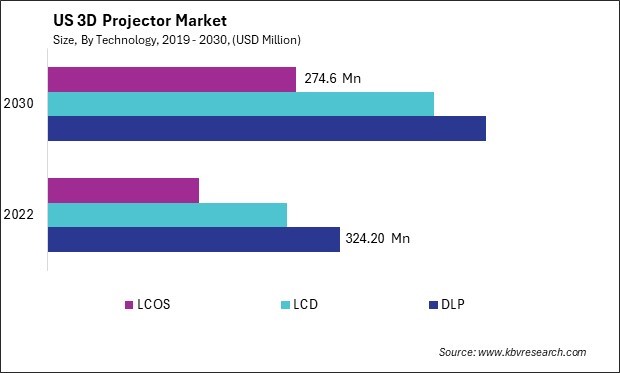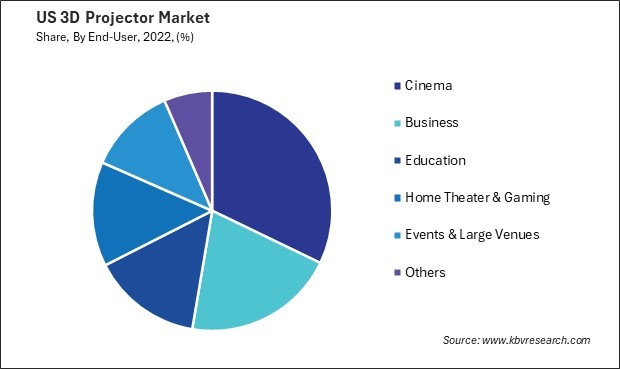Int'l : +1(646) 600-5072 | query@kbvresearch.com
Int'l : +1(646) 600-5072 | query@kbvresearch.com
Published Date : 14-May-2024 |
Pages: 101 |
Formats: PDF |
The United States (US) 3D Projector Market size is expected to reach $1.2 Billion by 2030, rising at a market growth of 5.9% CAGR during the forecast period. In the year 2022, the market attained a volume of 1995.1 Hundred Units, experiencing a growth of 5.9% (2019-2022).
The 3D projector market in the United States has experienced substantial growth in recent years, driven by increasing demand for advanced visual experiences in various sectors. 3D projectors have become integral to delivering immersive content from entertainment and gaming to education and business presentations. This surge in popularity is attributed to several key factors shaping the U.S. 3D projector market landscape.

One of the primary drivers is the relentless innovation in entertainment technology. The U.S., being a major hub for the global entertainment industry, has witnessed a robust adoption of 3D projectors in cinemas and home entertainment systems. Moviegoers seek an enhanced and captivating cinematic experience, and 3D projectors have proven to be a compelling solution for delivering lifelike visuals. The demand for 3D content has spurred the integration of advanced projection technologies, creating a lucrative industry for high-quality 3D projectors.
The COVID-19 pandemic had a mixed impact on the 3D projector market in the United States. While the closure of theaters and entertainment venues initially slowed down the demand for 3D projectors in the entertainment sector, there was a surge in demand for home entertainment systems as people spent more time indoors. As a result, sales of 3D projectors for home theaters and gaming setups witnessed a notable increase during the lockdown periods in the U.S. Additionally, the shift towards remote work and virtual events propelled the demand for 3D projectors in the corporate sector, as businesses sought innovative ways to engage remote audiences and conduct virtual meetings.
The gaming industry in the United States has witnessed a remarkable expansion, with a significant contribution from integrating 3D projectors. One of the primary factors fueling the adoption of 3D projectors in the gaming sector is the heightened demand for a more realistic and captivating gaming environment. Gamers are increasingly seeking an immersive experience that goes beyond traditional flat screens. 3D projectors provide an enhanced visual experience, allowing players to feel more connected to the virtual worlds they explore. This heightened level of engagement has led to a surge in the popularity of 3D projector gaming setups across the U.S. Gaming enthusiasts in the U.S. are known for their willingness to invest in cutting-edge hardware to enhance their gaming setups. The affordability and increasing availability of high-quality 3D projectors have made them attractive for those seeking to elevate their gaming experience. This has led to a surge in gamers adopting 3D projectors, creating a thriving industry for manufacturers and retailers. According to the International Trade Administration, the impact of the pandemic has driven sales in the video games sector, with the U.S. seeing a record 31% increase in consumer spending on video gaming and subscription services. Mobile gaming revenue has grown to $77.2 billion in 2020, a 13.3% increase. This trend has particularly impacted the 3D projector market, with a notable expansion witnessed in the U.S. Additionally, mobile gaming revenue has experienced a substantial growth of 13.3%, reaching $77.2 billion in 2020. Interestingly, 80% of U.S. gaming companies are actively exploring international industries to expand their sales as part of their growth strategy. This signifies a broader connection between the flourishing gaming industry and the burgeoning 3D projector market in the United States. The U.S. gaming community's penchant for innovation has played a pivotal role in the rapid integration of 3D projectors. Major gaming events and conventions across the country showcase the latest advancements in gaming technology, with 3D projectors taking center stage. Game developers are also aligning their creations with the capabilities of these projectors, delivering content specifically optimized for a three-dimensional projection. Thus, the widespread adoption of 3D projectors in the U.S. gaming industry reflects a growing demand for immersive gaming experiences driven by gamers' enthusiasm for cutting-edge technology.
The United States has witnessed a remarkable surge in adopting Digital Light Processing (DLP) technology within the 3D projector market, signaling a paradigm shift in how visual content is displayed and consumed. DLP, renowned for its superior image quality, high resolution, and vibrant colors, has emerged as a frontrunner in the U.S., transforming the landscape of 3D projection. One of the key drivers behind the growing popularity of DLP in the U.S. is its widespread integration in various sectors, including entertainment, education, business, and healthcare.
In the entertainment industry, cinemas nationwide increasingly opt for DLP-based 3D projectors to provide audiences with an immersive and visually captivating experience. Moreover, businesses in the U.S. are embracing DLP 3D projectors for presentations, conferences, and collaborative meetings. The technology's efficiency in displaying detailed visuals and intricate graphics has proven invaluable in corporate settings, contributing to enhanced communication and decision-making processes.
Healthcare facilities also leverage DLP-based 3D projectors for medical imaging and training. The precision and clarity offered by DLP technology play a crucial role in medical applications, enabling healthcare professionals to examine intricate details with unparalleled accuracy. Therefore, the widespread adoption of DLP technology in the U.S. 3D projector market, driven by its superior image quality and versatile applications across entertainment, business, education, and healthcare sectors, signifies a transformative shift in visual content display.

The 3D projector market in the United States has witnessed substantial growth, propelled by a combination of technological innovation, widespread adoption of immersive entertainment, and the increasing demand for advanced visual solutions across various industries. One of the major players shaping the U.S. 3D projector landscape is Epson America Inc., the American subsidiary of the global electronics giant Epson. Known for its commitment to delivering high-quality imaging solutions, Epson America has made significant strides in the 3D projector market. Their projectors are designed to cater to diverse applications, from home entertainment and gaming to business presentations and educational environments. Epson America's projectors stand out for their cutting-edge features, including high brightness, vibrant color reproduction, and user-friendly interfaces.
Texas-based Dell Technologies has also made a notable impact on the U.S. 3D projector scene. Leveraging its expertise in computer technology, Dell has introduced a range of projectors equipped with advanced imaging technologies and seamless connectivity options. The company's 3D projectors are particularly popular in business and education sectors, offering reliable performance and versatility for various applications.
Another key contributor to the U.S. 3D projector market is ViewSonic Corporation. Based in California, ViewSonic has established itself as a leading visual solutions provider, including projectors. The company's 3D projectors combine advanced display technologies with user-friendly features, targeting various applications such as home entertainment, education, and business presentations. ViewSonic's commitment to innovation and customer satisfaction has solidified its position in the competitive U.S. 3D projector market.
Texas Instruments, a global semiconductor design and manufacturing company headquartered in Dallas, has played a crucial role in the U.S. 3D projector market through its DLP (Digital Light Processing) technology. Many projector manufacturers utilize DLP technology to enhance image quality, color accuracy, and reliability in their 3D projection solutions. Texas Instruments' influence extends through partnerships with various projector brands, contributing to the overall advancement of 3D projection in the U.S. As the demand for 3D projectors continues to grow in the United States, these companies remain at the forefront of driving innovation and meeting the diverse needs of consumers and businesses.
By Technology
By Light Source
By Brightness
By Resolution
By End User